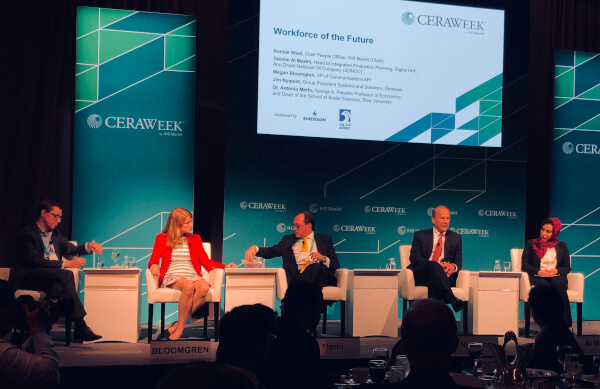What will the workforce of the future look like in the energy industries? That’s the question a panel at CERAWeek gathered to discuss. Emerson’s Systems & Solutions group president, Jim Nyquist, joined the panel to share perspectives on the role of technology in driving some of the changes that are upon us.

When asked why the oil and gas industry would attract newer professionals to the industry, one the panelists noted that there are several factors. The most obvious, which has not changed from prior generations, is the level of pay compared to other industries, but also the work-life balance compared with other industries. Energy is fundamental to the quality of life that people enjoy across the globe. Lack of access to energy Is a challenge for the upcoming generation to solve.
Given the rapid changes that surround us, what are the skills required for the flexibility needed to navigate these changes? Jim noted that technology can help in several ways. The first is to automate the mundane tasks. Automated workflows can allow people to use skills for higher level tasks. The second area that technology can help is in decision support. Increasingly sophisticated analytics help subject matter experts make better and faster decisions.
Mobility is critical technology to make data accessible by anyone, anywhere. Mobile applications enable energy professionals to live and work anywhere. Moving from status quo through a transformation requires change management. For most companies rewriting outdated work practices are required to take advantage of technology.
Finally, transforming the nature of work is not just about technology change, it’s about upskilling the employees to effective use the technologies and identify opportunities for further improvements.
Jim spoke of starting early with developing interest in science, technology, engineering and math (STEM). As an organization, Emerson encourages its employees in community outreach opportunities in grade schools, junior high and high schools to share why STEM is exciting and why it makes a great career. By understanding what’s possible at an earlier age, it enables young students to see the possibilities to explore and not ignore their innate STEM talents.
Support needs to continue through the university level with technology and curriculum support. It extends to companies with educational programs for upskilling their workforce.
Transparency and authenticity are absolutely critical for organizations. You can’t fake it. It’s too easy for people to go to Glassdoor and get the true story about companies and their cultures. It’s important for businesses to have a noble cause to pursue and purpose.
The panel was asked about how would the workforce literally work—sitting in offices like today or different? Several panelists envisioned much less hierarchy due to readily accessible information and a move to greater decentralization over more centralized approaches now.
